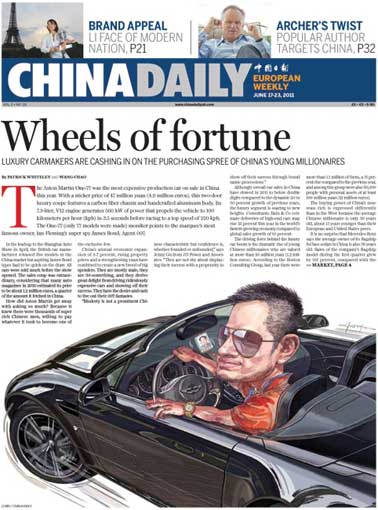Society
Educating the whole child
Updated: 2011-06-23 07:50
By Lin Qi and Guo Shuhan (China Daily)
|
Teachers and children play a game at Fengdan Waldorf Children's Home. Guo Shuhan / China Daily |

Schools adopting the educational principles developed by Austrian philosopher Rudolf Steiner are becoming increasingly popular with Chinese parents. Lin Qi and Guo Shuhan report.
More than a year ago, Zhang Tiange's first-grade daughter, Ding Ding, woke up at 5 one morning.
"She was to take the end-of-semester exams that day. I wondered why she was up so early when she said, 'Mom, what if I can't get full marks on the test?'"
Zhang had chosen a nearby ordinary public school when Ding Ding reached school age, hoping it would not put as much pressure on kids as the more sought-after ones. But she soon realized her folly.
"I didn't see her learning anything interesting or inspiring at school. I felt like we were preparing for battle every morning because we would have to hurry to the school to be on time for the morning reading of the classical Di Zi Gui (Standards for Being a Good Student), which, I think, is too obscure for young children. I don't understand why a child is made to feel so competitive at just 7," Zhang says.
Recalling her own childhood she says it was much more relaxed - there wasn't much homework, and no pressure to prepare for contests such as the Math Olympiad. The academic environment was nowhere near as competitive, she says, and hopes her daughter too can enjoy her childhood.
Last September, her family moved from Beijing's southern district to a northern suburb, to enroll her daughter in the second grade of the privately-run Nanshan Waldorf School.
"The school doesn't overload the children with information and assess how much they have absorbed through exams. Instead, it pays equal attention to a child's intellectual, emotional and physical growth. The children get to learn things that are truly useful for their future life," Zhang says.
In 1919, a school based upon the educational principles of the Austrian philosopher Rudolf Steiner opened in Stuttgart, Germany, to cater to children of employees of a cigarette factory called Waldorf-Astoria.
The name Waldorf then became a trademark of schools adopting Steiner's educational approach, which emphasizes interdisciplinary learning and creative thinking, and aims to develop a child into a free-spirited, morally responsible and integrated individual.
Figures from the Federation of German Waldorf Schools (Bund der Freien Waldorfschulen, an organization which certifies the use of the registered name "Waldorf") show that there were 998 Waldorf schools worldwide by January, 2010.
The Chengdu Waldorf School in Sichuan province, founded in 2004, is the first from the Chinese mainland to be accredited by the federation.
This year, another six schools nationwide received accreditation. Meanwhile, dozens of schools and kindergartens employing the Waldorf method are appearing in Beijing, Shanghai and Guangdong province, attracting a growing number of parents looking for an innovative education that gives play to a child's creativity.
Cao Lili, whose 5-year-old son Wang Wang attends the Fengdan Waldorf Children's Home, a community-based private kindergarten in Beijing's northwestern suburb, admits she was suspicious at first of the applicability of an overseas educational concept in China.
"Teachers here encourage children to play, to imagine and to explore what they are curious about, which is what they should do at this age," Cao says. "They also value each child's unique personality, unlike public kindergartens where most of the emphasis is on imparting information in preparation for primary school."
She says Wang Wang, who used to be too introverted to even talk to his peers, can now answer his teachers' questions and often takes the lead in a group.
Zhang was also surprised to see that her daughter's homeroom teacher also taught all the principal courses such as Chinese and math, and stays with the class through first to eighth grade.
This "looping" is a core idea in the Waldorf system and stands in marked contrast to public schools, where the homeroom teacher as well as the specialist teachers change when students enter a higher grade. Looping helps teachers understand a child's strengths and weaknesses and tailor their teaching to the pace the child is comfortable with.
Zhang says students are given no textbooks, just an empty notebook to note down what they have learnt. For instance, one day the teacher taught them the idiom hu jia hu wei (a fox borrows a tiger' fierceness) and asked students to not only write down the four characters but also draw a picture to capture the idea.
Ancient tales and animal fables help first and second-graders to understand the relation between humans and their environment and their interactions. By being exposed to two foreign languages, English and Japanese, they are taught the world is a diverse place with different ways of thinking.
She says students take academic courses in the morning, with the afternoons reserved for art, music, and sport.
"Many public schools care little about the children's physical development these days. Students are confined to the classroom," she says.
Zheng Juanrui works at the non-profit Beijing Zhiliangzhi Education Counseling Institution, which provides training for Waldorf teachers, as well as interested parents. She says the Waldorf system calls for high teaching standards.
"A teacher should understand Steiner's philosophy and know how to help children with different personalities fulfill their destiny. Teachers are free to refine the curriculum within the widely-accepted guidelines of the Waldorf system," she says.
"Students are not manufactured like assembly-line products. They are cultivated to be individuals with a balanced development of mind and body. The Waldorf system, in a sense, fosters the same values as treasured by Chinese tradition and culture."
Zhang Li, co-founder of Chengdu Waldorf School, says: "I can't say the Waldorf education suits every child, or that our students are superior to those from public schools. But children at Waldorf do show a strong enthusiasm for learning and exploring, and high self-discipline and teamwork."
Despite the growing popularity among parents, Waldorf schools come with a high price tag.
Zhang Tiange pays 24,000 yuan ($3,688) a year for her daughter at Nanshan Waldorf School, while Fengdan Waldorf Children's Home charges a monthly tuition of 3,000 yuan ($462) and a 400-yuan lunch fee, which is also higher than for public kindergartens.
"We use a lot of imported materials for our handicraft classes, organize outings and provide healthy organic lunches. Besides, our rentals are high," Wang Li, founder of the children's home, explains.
Hou Longlong, associate professor in education at Beijing Normal University, who has studied the Waldorf system, says many Waldorf schools abroad are not expensive and cater to ordinary families, because they often receive funding from non-governmental organizations and individuals.
"Many Chinese parents want their children to receive an elite education, but the Waldorf system actually encourages them to lead a normal life. Non-mainstream educational theories like Waldorf will only appeal to well-educated parents who can also afford the high tuition," he says.
Hou says that to promote their ideas, Waldorf schools in China should work closely with international Waldorf associations and Chinese professors interested in the Waldorf philosophy. He also suggests Waldorf schools cooperate with educational consultants to reach out to more parents.
"It would definitely improve our own educational model if educationists draw on alternative ideas, including the Waldorf theory," he says.
E-paper

Pret-a-design
China is taking bigger strides to become a force in fashion.
Preview of the coming issue
Franchise heating up
Party place
Specials

My China story
Foreign readers are invited to share your China stories.

Mom’s the word
Italian expat struggles with learning English and experiences the joys of motherhood again.

Lenovo's challenge
Computer maker takes on iconic brand apple with range of stylish, popular products

